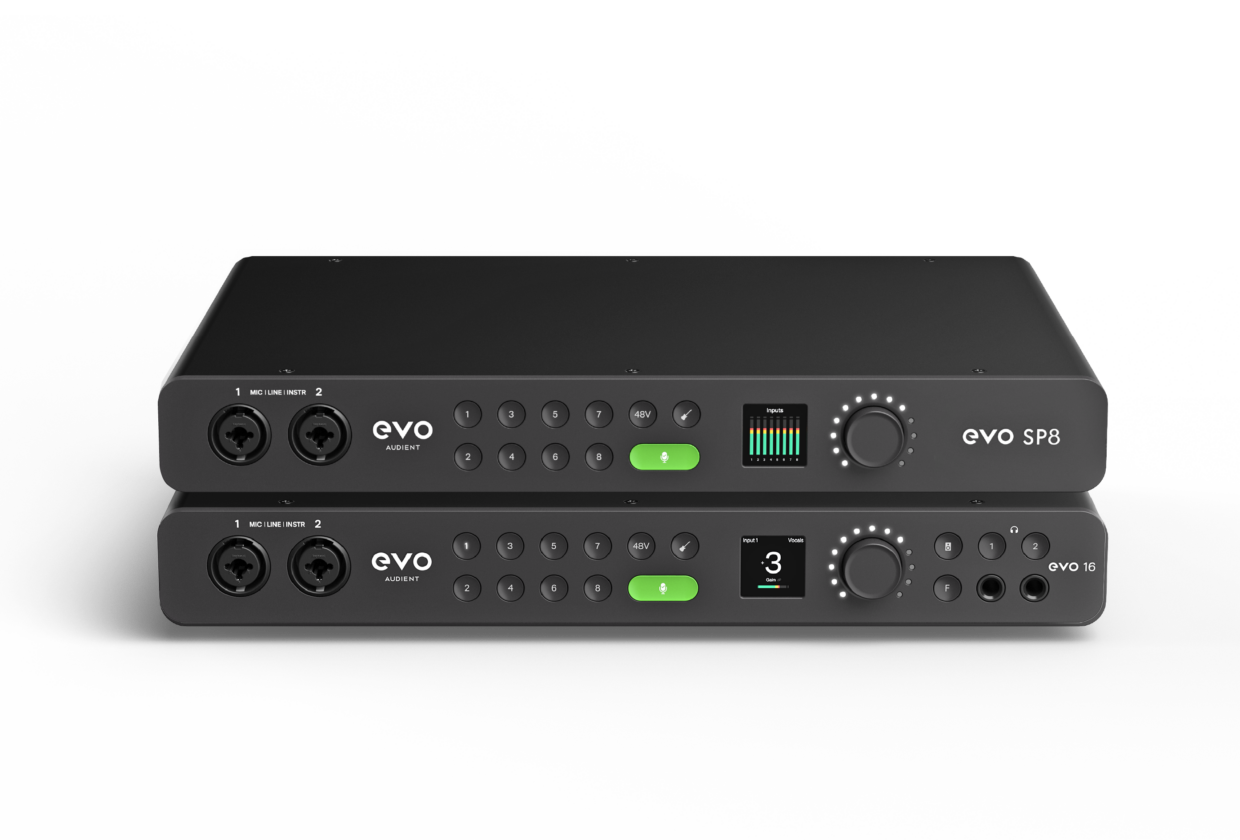At first glance, Audient’s EVO SP8 looks very much like Audient’s recently released Evo 16, but they are two very different devices. The Audient EVO SP8 is the latest addition to Audient’s range of smart preamps utilizing the same digitally controlled preamps as found on the EVO 16. The EVO 16 is an eight-channel Audio Interface while the EVO SP8 is an eight channel ADAT enabled channel expander purpose built to complement Audient’s EVO16 or any other audio interface equipped with at least one ADAT input and/or multiple ADAT inputs and outputs. As you might expect, the Audient EVO SP8 is designed to work seamlessly with Audient’s EV0 16, so the rest of this review will focus on using the two devices together.
When combined, the EVO SP8 and EVO 16 create what Audient calls an EVO expanded system giving you a powerful, flexible, cost-effective and expandable way to record. The EVO SP8 is constructed of an all-metal chassis and is designed for continuous professional use. Accessory rack ears for the EVO SP8 are available for $20. Out of the box, you get the EVO SP8, a quick-start guide and a barcode to download the full manual. Once you register your EVO SP8, you also get access to Audient ARC website, which has a wide variety of downloadable bonus software you can take advantage of when you register your EVO SP8.
The smartgain and motion UI features on the EVO SP8 work the same as found on the EVO 16. This means you can select channels individually or all eight (or 16 or 24 channels if you’re using two EVO SP8’s) at the same time and then let Audient’s smartgain algorithm do the rest of the work to set your gain levels.
The EVO SP8 features a multi-control wheel and full color high-resolution Motion UI screen as is found on the EVO 16. The first two inputs on the SP8 are located on the front of the device and can accept guitar or other quarter-inch devices, as well as line or microphone level inputs. There is a switchable JFET circuit available on the first two channels for tracking guitar and bass directly. On the back of the SP8 there are six mic line combo jack inputs and eight selectable analog or digital quarter-inch TRS outputs. Also, on the back of the SP8 there is a USC C input, but that’s only there to update the SP8’s firmware.
To connect your Audient SP8 to your EVO 16 you will need two ADAT Toslink cables to connect the EVO 16 and EVO SP8’s respective ADAT outputs to inputs. Once connected bi-directionally, (ADAT out on the EVO SP8 to ADAT in on the EVO 16 and then ADAT out on the EVO 16 to ADAT in on the SP8) both devices will be synced as one device, meaning the smartgain function will be transparent across both the EVO SP8 and EVO 16, which gives you the ability to set levels for up to 24 channels at one time. Note the EVO SP8’s firmware must be updated to be the latest version to correctly interface with the EVO 16.
Both the EVO 16 and EVO SP8 have two sets of ADAT IO, which enables you to sync eight channels up to 48K or four channels at 96K. The EVO SP8 can be used as an external clock or slaved to the EVO 16’s internal clock (the external clock rate needs to match sample rate on both devices). Note there is an auto option on the EVO SP8 that identifies and sets the clock source automatically. It is important to make sure your clock source is correctly terminated. Depending on how many devices you have connected, you may want to use the word clock connection on both devices via a 75-Ohm BNC cable.
While other audio interfaces equipped with ADAT expansion ports offer you an expanded channel count, only the EVO SP8 makes use of Audient’s smartgain algorithm. The key point here is that using Audient’s EVO 16 and EVO SP8 together you can set all 16 (or 24 inputs) directly from the EVO 16 desktop app. Combining the EV0 16 and EVO SP8 together creates an expanded system where both units essentially function as a single interface.
Note: you can select analog or digital outputs for all the EVO SP8’s eight line outputs on the back of the device to connect with your outboard gear or effect processors and then route them back into the EVO SP8 or directly onto your DAW. The EVO SP8’s ability to set either analog or digital line outputs is as far as I know an industry first. The EVO SP8 can also be used as a standalone eight-channel line mixer.
Once properly connected, the EVO SP8’s smartgain feature allows you to select individual or multiple channels from each device. As mentioned above, EVO SP8 gives you the possibility to dial in up to 24 channels in a few seconds using Audient’s Smartgain algorithm. If you are recording a live band with a fully mic’ed-up drum kit, guitar amps, and multiple vocal mics, the EVO expanded system will save you a significant amount of time by allowing you quickly and essentially automatically correctly set levels for all your tracks.
Recording with the EVO SP8 is straightforward. The preamps on both the EVO SP8 and EVO 16 can handle up to 60 dB gain range, which should be fine for using most microphones. Using the EVO 16 desktop app, you can set input levels, turn on phantom power, manually or automatically set your input gain levels, adjust monitor levels, create cue mixes and, in general, effectively manage all aspects of your sessions.
The Audient EVO SP8 is available now for $499 MAP.
Find out more at evo.audio/products/mic-preamps/evo-sp8/overview/














